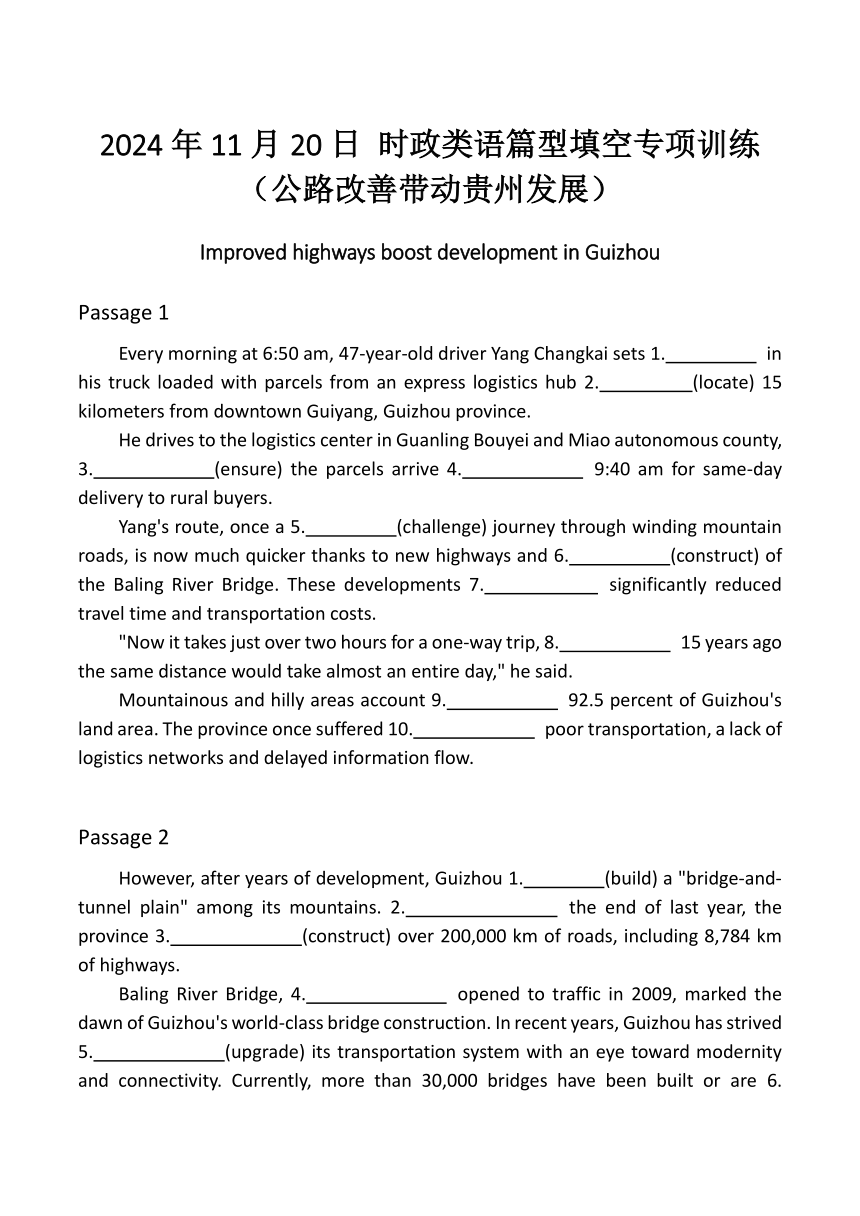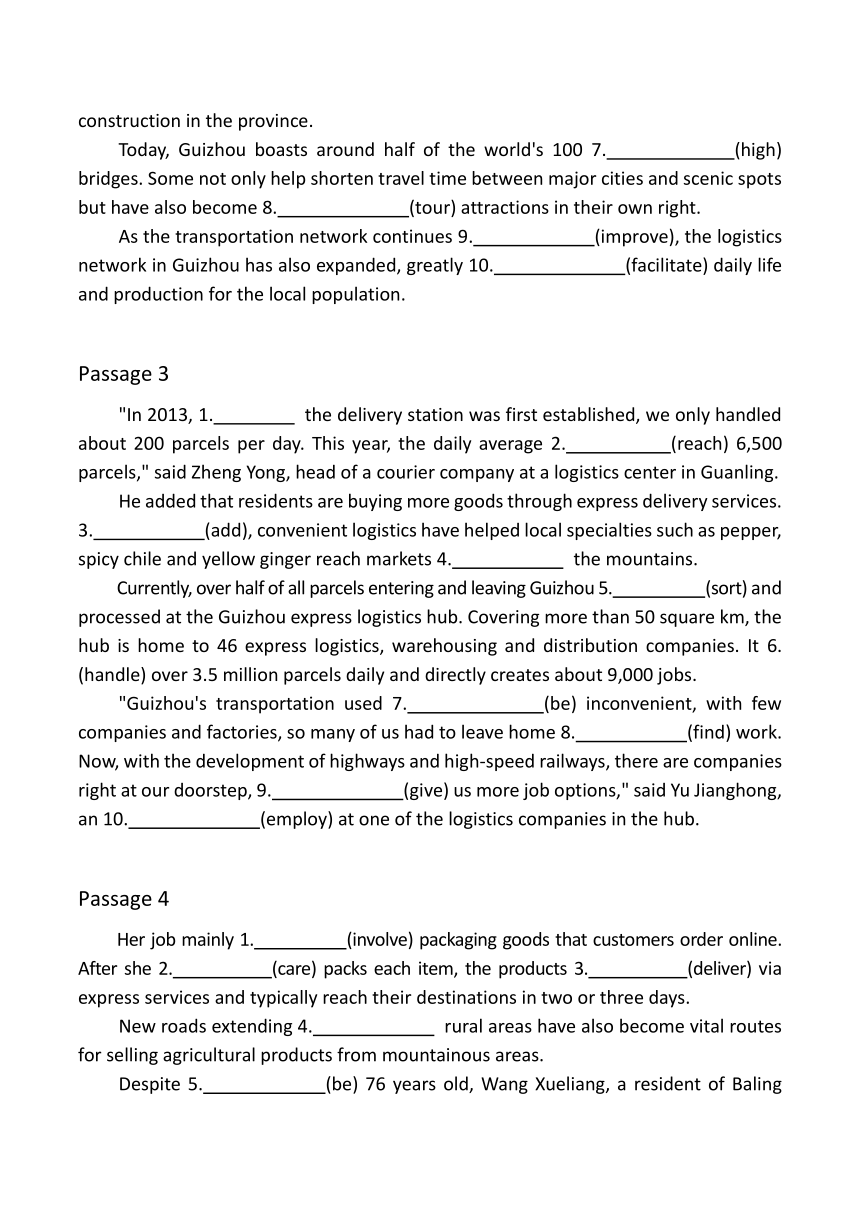2025届高三上学期英语一轮复习专项:2024年11月20日 时政类语篇型填空专项训练(公路改善带动贵州发展)(含答案)
文档属性
| 名称 | 2025届高三上学期英语一轮复习专项:2024年11月20日 时政类语篇型填空专项训练(公路改善带动贵州发展)(含答案) |  | |
| 格式 | docx | ||
| 文件大小 | 28.5KB | ||
| 资源类型 | 教案 | ||
| 版本资源 | 人教版(2019) | ||
| 科目 | 英语 | ||
| 更新时间 | 2025-01-24 17:01:36 | ||
图片预览


文档简介
2024年11月20日 时政类语篇型填空专项训练(公路改善带动贵州发展)
Improved highways boost development in Guizhou
Passage 1
Every morning at 6:50 am, 47-year-old driver Yang Changkai sets 1. in his truck loaded with parcels from an express logistics hub 2. (locate) 15 kilometers from downtown Guiyang, Guizhou province.
He drives to the logistics center in Guanling Bouyei and Miao autonomous county, 3. (ensure) the parcels arrive 4. 9:40 am for same-day delivery to rural buyers.
Yang's route, once a 5. (challenge) journey through winding mountain roads, is now much quicker thanks to new highways and 6. (construct) of the Baling River Bridge. These developments 7. significantly reduced travel time and transportation costs.
"Now it takes just over two hours for a one-way trip, 8. 15 years ago the same distance would take almost an entire day," he said.
Mountainous and hilly areas account 9. 92.5 percent of Guizhou's land area. The province once suffered 10. poor transportation, a lack of logistics networks and delayed information flow.
Passage 2
However, after years of development, Guizhou 1. (build) a "bridge-and-tunnel plain" among its mountains. 2. the end of last year, the province 3. (construct) over 200,000 km of roads, including 8,784 km of highways.
Baling River Bridge, 4. opened to traffic in 2009, marked the dawn of Guizhou's world-class bridge construction. In recent years, Guizhou has strived 5. (upgrade) its transportation system with an eye toward modernity and connectivity. Currently, more than 30,000 bridges have been built or are 6. construction in the province.
Today, Guizhou boasts around half of the world's 100 7. (high) bridges. Some not only help shorten travel time between major cities and scenic spots but have also become 8. (tour) attractions in their own right.
As the transportation network continues 9. (improve), the logistics network in Guizhou has also expanded, greatly 10. (facilitate) daily life and production for the local population.
Passage 3
"In 2013, 1. the delivery station was first established, we only handled about 200 parcels per day. This year, the daily average 2. (reach) 6,500 parcels," said Zheng Yong, head of a courier company at a logistics center in Guanling.
He added that residents are buying more goods through express delivery services. 3. (add), convenient logistics have helped local specialties such as pepper, spicy chile and yellow ginger reach markets 4. the mountains.
Currently, over half of all parcels entering and leaving Guizhou 5. (sort) and processed at the Guizhou express logistics hub. Covering more than 50 square km, the hub is home to 46 express logistics, warehousing and distribution companies. It 6. (handle) over 3.5 million parcels daily and directly creates about 9,000 jobs.
"Guizhou's transportation used 7. (be) inconvenient, with few companies and factories, so many of us had to leave home 8. (find) work. Now, with the development of highways and high-speed railways, there are companies right at our doorstep, 9. (give) us more job options," said Yu Jianghong, an 10. (employ) at one of the logistics companies in the hub.
Passage 4
Her job mainly 1. (involve) packaging goods that customers order online. After she 2. (care) packs each item, the products 3. (deliver) via express services and typically reach their destinations in two or three days.
New roads extending 4. rural areas have also become vital routes for selling agricultural products from mountainous areas.
Despite 5. (be) 76 years old, Wang Xueliang, a resident of Baling village in Guanling, still 6. (work) tirelessly in the fields.
This year, he 7. (plant) several types of vegetables, including loofah and gourd. With over 20 years of experience in vegetable farming, Wang earns a good income each year and lives a 8. (comfort) life.
"In the past, selling vegetables 9. (mean) carrying them on our backs, and it was hard to get a good price even in town, let 10. in the city. Now, with convenient highway access, trucks can drive straight to the fields to purchase our vegetables," Wang said.
参考答案
参考答案1
1.off 2.located 3.ensuring 4.by 5.challenging
6.construction 7.have 8.but 9.for 10.from
参考译文1
每天早上6点50分,47岁的司机杨长凯开着他的卡车,满载着包裹从距离贵州省贵阳市中心15公里的一个快递物流中心出发。
他开车到关岭布依族苗族自治县的物流中心,确保包裹在上午9点40分到达,当天送达给农村买家。
杨的路线曾经是一段充满挑战的山路,现在由于新的高速公路和八陵河大桥的建设,速度快了很多。这些发展大大减少了旅行时间和运输成本。
他说:“现在单程只需要两个多小时,但15年前,同样的距离几乎需要一整天。”
山地和丘陵地区占贵州土地面积的92.5%。该省曾经交通不畅,缺乏物流网络,信息流滞后。
参考答案2
1.has built 2.By 3.had constructed 4.which 5.to upgrade
6.under 7.highest 8.tourist 9.to improve 10.facilitating
参考译文2
然而,经过多年的发展,贵州在山间形成了“桥隧平原”。截至去年年底,全省新建公路20多万公里,其中高速公路8784公里。
巴陵河大桥于2009年通车,标志着贵州跨入世界级桥梁建设的曙光。近年来,贵州一直在努力升级其交通系统,着眼于现代化和互联互通。目前,该省已有3万多座桥梁建成或在建。
今天,贵州拥有世界上100座最高的桥梁中的一半。其中一些不仅有助于缩短主要城市和景点之间的旅行时间,而且本身也成为了旅游景点。
随着交通网络的不断完善,贵州的物流网络也不断扩大,极大地便利了当地居民的日常生活和生产。
参考答案3
1.when 2.reached 3.Additionally 4.beyond 5.are sorted
6.handles 7.to be 8.to find 9.giving 10.employee
参考译文3
“2013年,当快递站第一次建立时,我们每天只处理大约200个包裹。今年,平均每天收到6500个包裹,”关岭某物流中心快递公司负责人郑勇(音译)表示。
他补充说,居民通过快递服务购买了更多的商品。此外,便利的物流也帮助当地的特产,如胡椒、麻辣辣椒和黄姜,到达山区以外的市场。
目前,进出贵州的包裹中有一半以上是在贵州快递物流中心分拣和处理的。该枢纽占地50多平方公里,是46家快递物流、仓储和配送公司的所在地。它每天处理超过350万个包裹,直接创造了约9000个就业岗位。
“贵州的交通过去很不方便,公司和工厂很少,所以我们很多人不得不离开家去找工作。现在,随着高速公路和高速铁路的发展,我们家门口就有公司,给了我们更多的工作选择,”该枢纽一家物流公司的员工于江红(音)说。
参考答案4
1.involves 2.carefully 3.are delivered 4.into 5.being
6.works 7.planted 8.comfortable 9.meant 10.alone
参考译文4
她的工作主要是包装顾客在网上订购的商品。在她仔细包装好每件商品后,这些商品就会通过快递服务送达,通常在两三天内就能到达目的地。
延伸到农村地区的新公路也成为销售山区农产品的重要途径。
关岭八陵村村民王学良(音译)虽然已经76岁高龄,但他仍然孜孜不倦地在地里干活。
今年,他种了几种蔬菜,包括丝瓜和葫芦。王先生有20多年的蔬菜种植经验,每年都有不错的收入,生活舒适。
“在过去,卖蔬菜意味着要背在背上,甚至在镇上都很难卖个好价钱,更不用说在城里了。现在,随着高速公路方便访问,卡车可以直接驱动领域购买蔬菜,”王说。
Improved highways boost development in Guizhou
Passage 1
Every morning at 6:50 am, 47-year-old driver Yang Changkai sets 1. in his truck loaded with parcels from an express logistics hub 2. (locate) 15 kilometers from downtown Guiyang, Guizhou province.
He drives to the logistics center in Guanling Bouyei and Miao autonomous county, 3. (ensure) the parcels arrive 4. 9:40 am for same-day delivery to rural buyers.
Yang's route, once a 5. (challenge) journey through winding mountain roads, is now much quicker thanks to new highways and 6. (construct) of the Baling River Bridge. These developments 7. significantly reduced travel time and transportation costs.
"Now it takes just over two hours for a one-way trip, 8. 15 years ago the same distance would take almost an entire day," he said.
Mountainous and hilly areas account 9. 92.5 percent of Guizhou's land area. The province once suffered 10. poor transportation, a lack of logistics networks and delayed information flow.
Passage 2
However, after years of development, Guizhou 1. (build) a "bridge-and-tunnel plain" among its mountains. 2. the end of last year, the province 3. (construct) over 200,000 km of roads, including 8,784 km of highways.
Baling River Bridge, 4. opened to traffic in 2009, marked the dawn of Guizhou's world-class bridge construction. In recent years, Guizhou has strived 5. (upgrade) its transportation system with an eye toward modernity and connectivity. Currently, more than 30,000 bridges have been built or are 6. construction in the province.
Today, Guizhou boasts around half of the world's 100 7. (high) bridges. Some not only help shorten travel time between major cities and scenic spots but have also become 8. (tour) attractions in their own right.
As the transportation network continues 9. (improve), the logistics network in Guizhou has also expanded, greatly 10. (facilitate) daily life and production for the local population.
Passage 3
"In 2013, 1. the delivery station was first established, we only handled about 200 parcels per day. This year, the daily average 2. (reach) 6,500 parcels," said Zheng Yong, head of a courier company at a logistics center in Guanling.
He added that residents are buying more goods through express delivery services. 3. (add), convenient logistics have helped local specialties such as pepper, spicy chile and yellow ginger reach markets 4. the mountains.
Currently, over half of all parcels entering and leaving Guizhou 5. (sort) and processed at the Guizhou express logistics hub. Covering more than 50 square km, the hub is home to 46 express logistics, warehousing and distribution companies. It 6. (handle) over 3.5 million parcels daily and directly creates about 9,000 jobs.
"Guizhou's transportation used 7. (be) inconvenient, with few companies and factories, so many of us had to leave home 8. (find) work. Now, with the development of highways and high-speed railways, there are companies right at our doorstep, 9. (give) us more job options," said Yu Jianghong, an 10. (employ) at one of the logistics companies in the hub.
Passage 4
Her job mainly 1. (involve) packaging goods that customers order online. After she 2. (care) packs each item, the products 3. (deliver) via express services and typically reach their destinations in two or three days.
New roads extending 4. rural areas have also become vital routes for selling agricultural products from mountainous areas.
Despite 5. (be) 76 years old, Wang Xueliang, a resident of Baling village in Guanling, still 6. (work) tirelessly in the fields.
This year, he 7. (plant) several types of vegetables, including loofah and gourd. With over 20 years of experience in vegetable farming, Wang earns a good income each year and lives a 8. (comfort) life.
"In the past, selling vegetables 9. (mean) carrying them on our backs, and it was hard to get a good price even in town, let 10. in the city. Now, with convenient highway access, trucks can drive straight to the fields to purchase our vegetables," Wang said.
参考答案
参考答案1
1.off 2.located 3.ensuring 4.by 5.challenging
6.construction 7.have 8.but 9.for 10.from
参考译文1
每天早上6点50分,47岁的司机杨长凯开着他的卡车,满载着包裹从距离贵州省贵阳市中心15公里的一个快递物流中心出发。
他开车到关岭布依族苗族自治县的物流中心,确保包裹在上午9点40分到达,当天送达给农村买家。
杨的路线曾经是一段充满挑战的山路,现在由于新的高速公路和八陵河大桥的建设,速度快了很多。这些发展大大减少了旅行时间和运输成本。
他说:“现在单程只需要两个多小时,但15年前,同样的距离几乎需要一整天。”
山地和丘陵地区占贵州土地面积的92.5%。该省曾经交通不畅,缺乏物流网络,信息流滞后。
参考答案2
1.has built 2.By 3.had constructed 4.which 5.to upgrade
6.under 7.highest 8.tourist 9.to improve 10.facilitating
参考译文2
然而,经过多年的发展,贵州在山间形成了“桥隧平原”。截至去年年底,全省新建公路20多万公里,其中高速公路8784公里。
巴陵河大桥于2009年通车,标志着贵州跨入世界级桥梁建设的曙光。近年来,贵州一直在努力升级其交通系统,着眼于现代化和互联互通。目前,该省已有3万多座桥梁建成或在建。
今天,贵州拥有世界上100座最高的桥梁中的一半。其中一些不仅有助于缩短主要城市和景点之间的旅行时间,而且本身也成为了旅游景点。
随着交通网络的不断完善,贵州的物流网络也不断扩大,极大地便利了当地居民的日常生活和生产。
参考答案3
1.when 2.reached 3.Additionally 4.beyond 5.are sorted
6.handles 7.to be 8.to find 9.giving 10.employee
参考译文3
“2013年,当快递站第一次建立时,我们每天只处理大约200个包裹。今年,平均每天收到6500个包裹,”关岭某物流中心快递公司负责人郑勇(音译)表示。
他补充说,居民通过快递服务购买了更多的商品。此外,便利的物流也帮助当地的特产,如胡椒、麻辣辣椒和黄姜,到达山区以外的市场。
目前,进出贵州的包裹中有一半以上是在贵州快递物流中心分拣和处理的。该枢纽占地50多平方公里,是46家快递物流、仓储和配送公司的所在地。它每天处理超过350万个包裹,直接创造了约9000个就业岗位。
“贵州的交通过去很不方便,公司和工厂很少,所以我们很多人不得不离开家去找工作。现在,随着高速公路和高速铁路的发展,我们家门口就有公司,给了我们更多的工作选择,”该枢纽一家物流公司的员工于江红(音)说。
参考答案4
1.involves 2.carefully 3.are delivered 4.into 5.being
6.works 7.planted 8.comfortable 9.meant 10.alone
参考译文4
她的工作主要是包装顾客在网上订购的商品。在她仔细包装好每件商品后,这些商品就会通过快递服务送达,通常在两三天内就能到达目的地。
延伸到农村地区的新公路也成为销售山区农产品的重要途径。
关岭八陵村村民王学良(音译)虽然已经76岁高龄,但他仍然孜孜不倦地在地里干活。
今年,他种了几种蔬菜,包括丝瓜和葫芦。王先生有20多年的蔬菜种植经验,每年都有不错的收入,生活舒适。
“在过去,卖蔬菜意味着要背在背上,甚至在镇上都很难卖个好价钱,更不用说在城里了。现在,随着高速公路方便访问,卡车可以直接驱动领域购买蔬菜,”王说。
